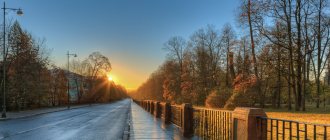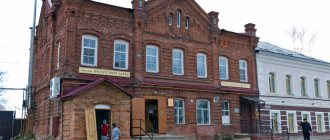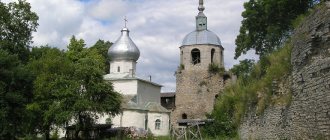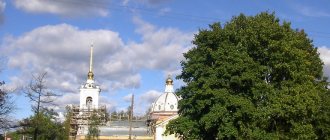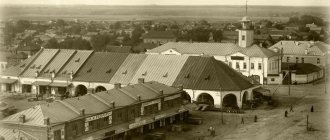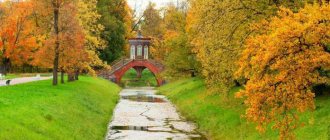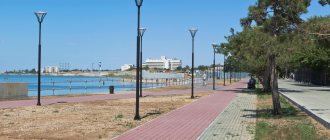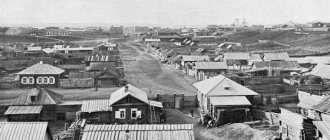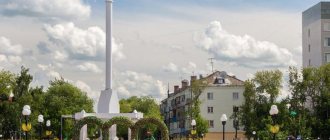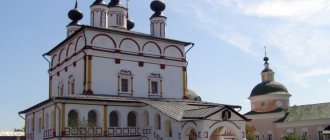| What to see on your own Route Pushkin Museums Stories, routes and tips from tourists with photos Where to stay in Pushkin Sightseeing tours Excursions from Pushkin for 1 day |
The city of Pushkin, formerly called Tsarskoe Selo, has preserved the atmosphere of tsarist Russia of the 19th century to this day. The settlement, as if straight out of a tourist postcard, was founded in 1710 as a country imperial residence. The main attractions of Pushkin are the architectural masterpieces and parks of the 18th–19th centuries. Literary festivals, holidays and folk festivals with a Russian flavor are often held here.
The settlement is quite small in area - getting around Pushkin in 1 day with sightseeing will not be difficult. In addition, the road to Pushkin from St. Petersburg will not take more than an hour. Tourists and St. Petersburg residents come to Tsarskoe Selo to immerse themselves in the atmosphere of Imperial Russia and for poetic inspiration, to stroll in luxurious parks and visit legendary museums. A detailed guide to Pushkin for 1 day is below.
Catherine Palace Photo: © Natalia Tarasova
What to see in Pushkin in 1 day on your own
Pushkin-Tsarskoe Selo became a city in 1808; the settlement around the residence began to grow in the 70s of the 18th century. The city architect of the new settlement was the Scotsman William Geste. According to the urban development plan, Tsarskoe Selo was divided into symmetrical blocks with gardens and vegetable gardens, and at the same time 4 squares were laid out: Znamenskaya, commercial, semicircular and administrative. From 1811, for 30 years, the famous Tsarskoye Selo Lyceum was located in the wing of the Catherine Palace. The Tsarskoye Selo railway was built in 1837. By the middle of the 19th century, Tsarskoe Selo was considered one of the most comfortable cities, and in 1887 it was the first fully electrified city in Europe. The first waste incineration station and biological sewage treatment station in Russia appeared here.
The city became Pushkin in Soviet times, in 1937. Before this, in the post-revolutionary period, the city changed 2 names: Soldatskoe Selo (from October 1917 to 1918) and Detskoe Selo (from November 1918 to 1937).
By the way, the last Russian emperor preferred Tsarskoe Selo to St. Petersburg. The Alexander Palace was the main residence of Nicholas II. Members of the imperial family were kept under house arrest there after the February Revolution.
Catherine Park Photo: © Natalia Tarasova
Catherine's Cathedral
Arriving in the city, on the way to the main tourist attraction of Pushkin, tourists examine the Catherine Cathedral . It’s worth starting a one-day walk around Pushkin from here. The first cathedral on this site was founded in 1835. The architect of the temple was K. A. Ton. In the first years of Soviet power, the cathedral continued to operate, although atheist processions took place around it. In 1938, the archpriest of the temple was relieved of his post. In 1939, on June 10, St. Catherine's Cathedral was blown up. The plans of the Soviet authorities included the construction of a park and architectural ensemble named after Pushkin on this site. In the 60s, a monument to Lenin was erected on the site of the remains of the cathedral. In 2004, a group of unknown persons toppled the Lenin monument from its pedestal. Construction of the new cathedral began in 2007, and the gilding of the domes was completed in 2014. The temple was built according to Thon's first design. Now the Catherine Cathedral is active; in the basement there is a museum of the Tsarskoye Selo deanery.
Next to the cathedral are the shopping arcades of Gostiny Dvor . The structure was erected in the mid-19th century on the site of a former wooden shopping complex that was destroyed by fire. The building is very similar to the St. Petersburg Gostiny Dvor - the one-story building is also framed by an arched gallery on all sides. The shopping mall complex still performs its function. On the courtyard side there is the Tsarskoye Selo market .
Catherine's Cathedral Photo: © Natalia Semchina
Catherine Palace
The palace in Tsarskoe Selo was the official summer residence of three Russian empresses: Catherine I, Elizaveta Petrovna and Catherine II. The Imperial Palace was founded in 1717 as the summer residence of Catherine I. Construction was completed 7 years later. According to the original plan, the palace was not such a large-scale building as it is now. It was a small house, 2 floors high, in the Dutch style. The expansion and improvement of the palace began in 1743, by order of Elizabeth Petrovna. Russian architects were responsible for the project. But in 1852, Elizaveta Petrovna again ordered the reconstruction of her residence, this time by Bartolomeo Rastrelli. The palace, as we see it now, is Rastrelli’s project in the Russian Baroque style. The palace was also the residence of Catherine the Great, although the empress herself considered its decoration old-fashioned and called Elizabeth Petrovna too wasteful.
More than 100 kg of gold was spent on gilding the decoration of the facade and the statues on the roof.
Catherine Palace Photo: © Svetlana Turner
The most famous room of the palace is the Amber Room or Amber Cabinet. The decoration of the room was made at the beginning of the 18th century and presented to Emperor Peter the Great by the King of Prussia. Initially, the decoration decorated the Winter Palace, but in 1755 it was moved to Tsarskoe Selo. During the years of German occupation, the decoration of the room was taken to Konigsberg (present-day Kaliningrad). Current location unknown. The modern decoration of the Amber Room is the work of restorers. The Lyon Hall is one of the most beautiful rooms of the palace. The walls of the main hall are decorated with silk from Lyon. Other notable rooms and buildings include: the Arabesque Hall , the Chinese drawing room of Alexander I, the silver dining room, the Palace Church .
You can visit the Catherine Palace at any time of the year. But during the high season (from May to October) it is worth booking tickets in advance - there are huge queues at the entrance. For an additional cost, you can take part in family interactive programs that are held in the palace or take part in the promenade performance “Eternal Return”.
More details: Catherine Palace
Catherine Palace Photo: © Natalia Tarasova
Catherine Park
An extensive park area is part of the Tsarskoye Selo Museum-Reserve . Catherine Park is an architectural monument of the 18th–19th centuries. It is divided into 2 parts: the regular Old Garden and the landscaped English Park. The park on this site appeared during Swedish rule. In the 17th century, the estate of a Swedish magnate, Sarskaya Manor, was located here. After the victory over the Swedes, Peter I donated this land to Count A.D. Menshikov, but later gave it to his wife, Catherine I. The western side of the park remained wild - wild boars, moose and hares were hunted there. The banks of the Big Pond were gradually strengthened, a canal was dug, and a garden was laid out with ledges on the natural hillside. The eastern, higher part began to be called the Upper Garden, and the other - the Lower Garden.
Under Elizabeth Petrovna, not only the palace was rebuilt, but also the park. “Hermitage” , “Grotto” , “Hall on the Island” , a stone fence with a gate (design by Rastrelli), a system of canals and ponds date back to the time of her reign Under Catherine the Great, a new park was laid out next to the Old Garden - the English Park, according to the canons of fashion of those times. Artificial hills were created, new ponds were dug, pavilions were erected and several thousand trees were planted. Thus, Catherine Park acquired a modern look. If you look at the map, the Elizabethan part of the park is lined with parallel and diagonal paths, while the Catherine’s part is lined with winding lines of paths.
Hermitage Pavilion Photo: © Andrey Panin
The park is notable not only for its picturesque nature, but also for its cultural and historical heritage. Many sculptures are monuments erected in honor of the victories of the Russian Empire. Thus, the sculptures in the Old Garden depict the power and glorious victories of the newly formed empire: the statue of Hercules is an allegorical image of Peter I; and the Amazon leaning on a shield is a memory of the victory in the Northern War. In memory of the victories of Catherine II. the Morea and Chesme columns, the Admiralty and a number of other buildings were erected a Chinese gazebo was erected in the park , emitting a melodic creaking sound; Turkish bath ; hanging garden; concert hall. One of the most beautiful buildings is the Cameron Gallery with its snow-white colonnade and antique-style busts. From the gallery you can clearly see the panorama of the park and the Big Pond. The Marble Bridge , is also decorated with a colonnade . Many monuments of Catherine Park are mentioned in Pushkin’s poems.
Turkish bath Photo: © Elena Sarieva
Alexandrovsky Park
Another extensive park area of Pushkin is definitely worth seeing in 1 day. Alexander Park is not as solemn as Catherine Park. But more cozy and peaceful. The improvement of the territory began in the 40s of the 18th century. Then the park was divided into 4 squares and surrounded by the Cross Canal. In 1755, the bulk Mount Parnassus was created. In the 80s of the same century, the Chinese Village was built in the park - a complex of one-story houses with an observatory. They were complemented by the Chinese Bridge and the Chinese Theater . Later the houses were turned into residential ones - each had its own garden.
The park is divided into 2 parts: the regular New Garden and the Landscape Park. Of the notable buildings, the complex of buildings in the neo-Gothic style stands out: Chapelle , Lama's Pavilion , Arsenal , White Tower and Pensioner Stable . The old horses of Emperor Alexander Pavlovich spent their last years in the stable. Nearby is the cemetery of the imperial horses. A children's house on an island in the center of the pond was built for the children of Emperor Nicholas I to play. Visiting Alexander Park is free.
Alexander Park Photo: © apreleva1409
Alexander Palace
Previously, another imperial residence was called the New Tsarskoye Selo Palace. Built in the style of Palladian classicism at the end of the 18th century, the palace was a gift from Catherine II to her grandson, Grand Duke Alexander Pavlovich. The building is not as magnificent and richly decorated as the Catherine Palace. Alexander Palace building has 2 floors. The building is elongated in length and has double wings on the sides. The northern façade is decorated with two rows of columns.
Under Nicholas II, the Alexander Palace became the main residence of the emperor's family. All important celebrations took place here, including the celebration of the 300th anniversary of the Romanov dynasty. During the Great Patriotic War, the building housed the German headquarters and the Gestapo, and there was a prison in the basements of the palace. Restoration work on the palace continues to this day and causes indignation among the people - contrary to the principles of scientific restoration, the original structures were crudely rebuilt and destroyed. Now only three rooms have partially preserved the interior decoration and fragments of the original decoration of the pre-revolutionary years.
More details: Alexander Palace
Alexander Palace Photo: © kristina6306
Fedorovsky town
Exit the Alexander Garden and, after crossing the Farmer's Road, enter the Farmer's Garden . Fedorovsky town is located here . In Rus', this name meant the house of clergy. But in Pushkin, the Feodorovsky town is a whole complex of buildings headed by the Feodorovsky Cathedral . The buildings are surrounded by a battlement with 6 watchtowers, the main entrance is through a white stone gate with fine carvings. Outside the walls are the War Chambers , the imperial station, the temple and the barracks of the infantry regiment.
Feodorovsky Cathedral was built in 1909–1912 on the highest point of the town. On the square in front of the cathedral, Nicholas II and members of his family planted one oak tree each - only 4 oak trees have survived to this day. Most of the exterior decoration of the buildings has only been partially preserved; restoration of the buildings continues. The territory was transferred to the Russian Orthodox Church. The plans are to establish a synodal courtyard of the Russian Orthodox Church with the residence of the patriarch in Fedorovsky town. In this case, the territory of the town will be closed to tourists.
Details: Fedorovsky town
Fedorovsky town Photo: © Tatiana Egorova
The Egyptian Gates
Leaving the territory of Fedorovsky town, move along Palace Street to the Egyptian Gate . The ceremonial gates were erected in 1830. Previously, the city border passed here, and the gate was located at the entry point from St. Petersburg. The gate consists of two towers connected by a fence. The stone pylons were previously guard rooms. The towers are lined with sandstone slabs, which the Egyptians used for construction. The slabs bear bas-reliefs with scenes from Egyptian myths. But you shouldn’t look for meaning in the ancient Egyptian inscriptions - this is just a decorative element, they were applied arbitrarily. Here, at the site of the previous exit from the city, the 1-day route through the sights of Pushkin ends.
Overview of all the sights of Pushkin
Egyptian Gate Photo: © Natalia Semchina
A short walk around the city of Pushkin
I have been to the city of Pushkin several times. Usually she came there only for a short time, when she went on excursions to palaces. In 2012, Elena Astashkevich invited me to her place, and I enthusiastically walked, studied and discovered a magnificent city, which, as it turned out, has many interesting architectural monuments.
Let's walk along several streets of Pushkin and admire the old houses, each of which has a long interesting history.
Pushkin (until 1918 - Tsarskoe Selo, from 1918 to 1937 - Detskoe Selo) is a city within the Pushkinsky district of the federal city of St. Petersburg and its intra-city municipal formation. A large tourist, scientific, educational and military-industrial center. Included in the list of monuments protected by UNESCO, as part of the object “Historical Center of St. Petersburg and related complexes of monuments.” At the beginning of 2010, the population of the city of Pushkin was 99,388 people, according to the 2010 population census (as of October 14) - 92,889 people. The St. Petersburg-Vitebsk railway line runs through the city; the Tsarskoe Selo railway station and the 21st km stop are located on its territory. The distance between Vitebsky Station in St. Petersburg and Tsarskoye Selo is 23 km. The main post offices of St. Petersburg and Pushkin are located at a distance of 24 kilometers in a straight line. The city is located within the Prinevskaya lowland. Pushkin was founded in 1710 as the imperial country residence of Tsarskoe Selo, a city since 1808. The city is home to the Tsarskoye Selo Museum-Reserve, a monument to urban planning art and a palace and park ensemble of the 18th - early 20th centuries. The reserve includes the Catherine Park with the Catherine Palace and other buildings (from Wikipedia).
The Lyceum and the Catherine Palace from the side of Dvortsovaya Street The Lyceum and the Catherine Palace from the side of Dvortsovaya Street
And here is the Lyceum Garden , which is adjacent to the Tsarskoye Selo Lyceum and the Church of the Sign. In the center is a monument to A.S. Pushkin by R.R. Bach.
Lyceum Garden
Information about the Lyceum Garden Monument to Pushkin in the Lyceum Garden
Nearby is the ancient Church of the Sign, the melodic ringing of its bells makes you mentally transport yourself to the brilliant 18th century.
Znamenskaya Church
Interior decoration of the Church of the Sign Palace (Resurrection) Church
The ancient Gostiny Dvor, built in 1866, has been preserved. And today trade is in full swing here, with fashion stores located.
Gostiny Dvor in the center of Pushkin
On the square nearby is the Cathedral of St. Catherine the Great Martyr, recreated in 2007-2010. And the first cathedral on this site was founded back in 1835; construction was carried out under the leadership of the famous architect K.A. Ton. On June 10, 1939, the temple was blown up.
Cathedral of the Holy Great Martyr Catherine Gostiny Dvor
House in Pushkin
House in Pushkin
At the corner of Moskovskaya and Konyushennaya streets stands the chapel of the Holy Blessed Prince Igor of Chernigov. During the Great Patriotic War, the Nazis carried out mass executions at this place.
Chapel of the Holy Blessed Prince Igor of Chernigov
Chapel of the Blessed Prince Igor of Chernigov
Chapel of the Blessed Prince Igor of Chernigov
Another famous monument is the fence of the Catherine Palace and the cast-iron triumphal gate “To my dear colleagues,” erected according to the design of the architect V.P. Stasov in 1817 in just 92 days.
Fence of Catherine Park
Gate "To my dear colleagues"
Sailors
Gate "To my dear colleagues"
Opposite the triumphal gate is the Reserve Palace, built in 1817-1824 as a country palace of Count V.P. Kochubey (prince from 1831) and his wife, state lady M.V. Kochubey. In 1835, the palace was purchased by the treasury for Grand Duke Nikolai Nikolaevich, and in 1859 it became officially known as the Tsarskoye Selo Reserve Palace. Since 2010, the Wedding Palace has been located here.
Dacha Kochubey (Reserve Palace)
Dacha Kochubey (Reserve Palace)
Store of the Guards Economic Society
Store of the Guards Economic Society Bagration Estate
At the intersection of Sofiysky Boulevard and Moskovsky Prospekt you can see the Moscow Gate. Their other name - Friedenthal - refers us to the colony of German settlers "Friedenthal", which in former times was located behind them. The first wooden booths with barriers were built here by order of Emperor Paul I in 1797. In 1830-1831 they were replaced by stone gates in the Empire style.
City of Pushkin (St. Petersburg)
Moscow (Friedenthal) Gate
On Naberezhnaya Street, on the shore of the Kupalny Pond, you can see another monument - the building of the Bank Notes Factory, built in 1785. Previously, the Petrovskaya Mill was located here. In former times it was a secret facility.
Banknote Factory
Factory of banknote papers Imperial Nikolaevskaya Tsarskoye Selo Gymnasium
Sadovaya street
Tsarskoe Selo (the city of Pushkin) is incredibly beautiful. Here you can spend more than one day leisurely strolling along the ancient quiet streets, looking at the palaces and dachas of the most brilliant families of the Russian Empire. We saw only a small piece of this wonderful city. I hope you liked it.
© Website “On the Roads of the Middle Way”, 2009-2021. Copying and reprinting of any materials and photographs from the site anashina.com in electronic publications and printed publications is prohibited.
Route
A walk around the city of Pushkin begins with a tour of Cathedral Square and the restored Catherine Cathedral . Walk past Gostiny Dvor and move along Oranzhereynaya and further along Sadovaya Street to the Catherine Palace . After visiting the palace rooms, go for a walk in the park. Walk along the Cameron Gallery and then go down to the Big Pond, leisurely examining the pavilions and sculptures. Go around the pond, examining the legendary Chesme Column and the building of the Turkish Baths . Walk across the Marble Bridge and be sure to visit the Creaky Gazebo .
Take the second half of the day to explore the Alexander Park and Palace , as well as the Fedorovsky town . The route ends at the Egyptian Gate . The length of the route is short, but due to the abundance of attractions in the parks, the walk will take almost the whole day. In the summer, it’s worth taking a snack with you and having a picnic on the shore of a pond or in the shade of ancient oak trees. In winter, you can have a snack at one of the coffee shops.
Cameron Gallery Photo: © Svetlana Turner
Attractions
So, what can you see in this city steeped in history?
First of all, a tourist who wants to explore Tsarskoye Selo should pay attention to the historical center. The main attraction of the city is, of course, its famous parks and palaces .
Catherine Park , with its numerous sculptures, manicured lawns and flower arrangements, and historical buildings, is the pride of Pushkin, and tourists usually immediately pay attention to it.
Adjacent to the park is the Catherine Palace , built in the Baroque style and also worthy of a visit. The most admired place is usually the famous Amber Room, the decoration of which was restored only in 2003.
Next to the palace there are rows of souvenir shops where you can find almost everything your heart desires: T-shirts with prints of St. Petersburg and Pushkin, mugs, amber jewelry, scarves and bags with themed designs, knives, pendants and much, much more.
Not far from the market there is the Singing Tower restaurant - one of the best in the city, as well as a wonderful observation deck overlooking the entire city.
It is impossible not to pay attention to Alexander Park. Their care is not nearly as careful and careful as for Ekaterininsky, but it deserves no less attention. In the Alexander Park there are oak trees planted personally by Nicholas II, the only museum in Russia of the First World War “Ratnaya Palata”, many pavilions with a rich history: the Arsenal, the White Tower, Feodorovsky Cathedral.
Outside the parks, on buildings that are inconspicuous at first glance, you can see signs telling about which famous people lived in these houses and when.
Pushkin Museums
Getting to know the city of Pushkin would be incomplete without visiting one of the museum exhibitions. Set aside 1-2 hours to dive even deeper into the history of Tsarskoe Selo and learn about its cultural past and the famous personalities who lived here.
Historical and Literary Museum
The Pushkin Historical and Literary Museum is located in a two-story ocher-colored building . The museum has several exhibitions dedicated to the history and culture of the city. The most extensive exhibition is dedicated to the history of Tsarskoye Selo. The museum's collection represents the history of the city from archaeological finds to archival photographs of the last century. Separate exhibitions are dedicated to poets who studied at the Tsarskoye Selo Lyceum and urban architecture. There is a hall stylized as an old tavern, where Tsarskoye Selo lyceum students spent time.
Panoramic view of the building of the Historical and Literary Museum of the city of Pushkin
Museum-dacha of A. S. Pushkin
A small house in beige and white colors is the dacha of the poet Alexander Pushkin . The great poet and his wife Natalya Goncharova settled here in 1831. The estate has 10 rooms, 8 of which were rented by the poet and his wife, and the widowed mistress lived in two. Many famous works were written here, including the legendary “Letter of Onegin to Tatyana.” The interiors have remained virtually untouched.
Pushkin's dacha Photo: © Elena Yakhontova
Memorial Lyceum Museum
The Imperial Tsarskoe Selo Lyceum was founded in the wing of the Catherine Palace in 1811. It was in this institution that Alexander Sergeevich Pushkin studied. Now the building houses a memorial museum . Visitors can explore the classrooms, assembly hall, library, pupils’ rooms with the preserved ascetic atmosphere of that time, including the room of the lyceum student Pushkin. The exhibition presents the works of students and original books from the library of that time.
Tsarskoye Selo Lyceum Photo: © Irina Dementieva
Museum-Theater "Pushkin's Tales"
With children it is worth visiting the museum-theater “Pushkin's Tales” . The museum hosts interactive programs and performances based on Pushkin's fairy tales. Children can play in fairy-tale interiors or take part in a master class. The list of museum-theater programs is constantly changing - check before your visit what events you can attend.
More details: Pushkin Museums
Monument to Pushkin Photo: © Tatyana Lisker
Tsarskoe Selo (Pushkin) photo
Tsarskoye Selo is a palace and park ensemble in the city of Pushkin. Pushkin is a city within the Pushkinsky district of St. Petersburg. It was founded in 1710 as the imperial country residence of Tsarskoye Selo. Since 1808 it began to be considered a city. Currently included in the list of monuments protected by UNESCO.
The former royal residence with a palace, parks, numerous buildings, monuments, and sculptures is currently a museum-reserve that is open to visitors. Tsarskoe Selo is one of the most popular routes for tourists from all over the world who come to Russia on vacation. Tsarskoe Selo has historical and architectural artistic value. It consists of the Great Catherine Palace, which, among other things, houses the famous Amber Room, Catherine Park and Alexander Park. The entire complex covers an area of 107 hectares. The parks contain a large number of historical attractions and simply beautiful and incredibly picturesque places. Visit Tsarskoe Selo and spend your day off walking through the most beautiful places where once only high-ranking persons could walk, breathe fresh air, get acquainted with part of history, feed squirrels and ducks, sit in a shady grove, perhaps the best choice on a warm sunny day .
Upper Bath (Their Highnesses Soap House, built 1777-1779)
Catherine Palace
Hermitage Alley
Cameron Gallery
Cameron Gallery. Built in 1784 for walks and philosophical conversations. The upper tier is decorated with bronze busts of the idols of Catherine II.
Evening hall. Construction 1796-1810. Used as a concert hall.
The kitchen is a ruin. Built by G. Quarenghi in the 1780s.
Creaky gazebo. Built in 1778-1786. It got its name from the weather vane, which creaks a lot when rotating in the wind.
Tower ruin. Built in 1771. Symbol of the fall of the Ottoman Porte. The tower resembles the ruins of a fortress, from the top platform of which there is a stunning view of the surrounding landscape.
Marble Bridge. Colonnade on a granite base with stairs on the sides. Built in 1774.
Pyramid. Erected in 1782-83. Catherine II’s favorite dogs, Tom Anderson, Zemira and Duchess, are buried at the foot of the pyramid.
Turkish bath. Built in 1828-29.
Big lake in Catherine Park.
Pavilion "Hermitage". Built according to Rastrelli's design in 1748-1756.
Chesme Column. Erected in 1774-78. in honor of naval victories in the Russian-Turkish War. The column is carved from pink and white Olonets marble, decorated with rostras and bronze bas-reliefs. The top of the column is crowned with an eagle trampling on a crescent.
Do you like to spend your free time outdoors and are you into fishing? Learn everything about shell fishing to make fishing even more interesting and effective. A large number of useful articles and materials on topics of interest to you on the Avitko website.
Stories, routes and tips from tourists with photos
You can find out what other travelers recommend to see in Pushkin in 1 day in their reviews. Tourists share ready-made routes, unusual attractions and recommendations on how to productively organize their time in Pushkin. In the tourists' reports you will find tips on booking tickets to the city's museums, descriptions of tourist sites with realistic photographs.
- The story “Let's go to Tsarskoe Selo!” from Natalia Tarasova.
- The story “Parks of Tsarskoe Selo” from Elena Sarieva.
- The story “Cream Cake and the Surroundings” by Svetlana Turner.
- Photo album “Tsarskoe Selo. Winter" from Tatyana Egorova.
- Photo album “Catherine Palace (Tsarskoe Selo)” from Elena Sarieva.
All tourist reviews about trips to Pushkin on Tourist. RU
Tsarskoye Selo Lyceum Photo: © kristina6306
A little history
First of all, it is worth introducing the reader to the history of the city. Initially, the territory where Pushkin is now located belonged to Sweden, and there was an estate of a Swedish magnate called “Sarskaya Manor” on it. After the Northern War, which lasted from 1700 to 1721, it became part of the Russian Empire.
Catherine
Several years after the end of the war, Peter the Great handed over the muse to his beloved Martha Skavronskaya, and it was this event that marked the transformation of the old estate, located in a marshy area, into a luxurious royal residence.
Marta Skavronskaya immediately set about arranging the new property. Construction proceeded quickly, and already in 1725 the residence was renamed Tsarskoe Selo, and the first palace, quarters for servants, etc. were built. After the death of Peter, his beloved ascended the throne under the name of Ekaterina Alekseevna, and a period of prosperity began for Tsarskoe Selo.
Technical innovations began to appear in the town, palaces and parks were rebuilt, and the best gardeners and architects were invited.
It was at this time that the so-called Russian Baroque became especially widespread, in no way inferior in splendor to its European counterpart.
During this period, numerous buildings in different styles appeared in Tsarskoe Selo, the famous Rastrelli built a pavilion called the Hermitage, and the city itself flourished.
After Catherine's death, Tsarskoe Selo was quiet for a long time. Pavel came to power, skeptical of Catherine’s whims, which is why all the construction projects unfinished during her lifetime stopped.
Catherine II
Under Catherine II, buildings in the style of classicism began to appear in Tsarskoye Selo, the city became more aristocratic and quieter.
The nineteenth century became a time of blissful calm for the city: the era of magnificent balls and pretentious luxury was over, but for the royal family the residence remained a favorite place for relaxation and entertainment.
The Tsarskoye Selo Lyceum was built, which was planned as an educational institution for future government workers, but this plan failed miserably - everyone leaving the walls of the Lyceum turned out to be rebels.
XX century
The twentieth century became a difficult time for Tsarskoye Selo. It was here that Nicholas II abdicated the throne and was imprisoned. Also in Pushkin, the first murder of a clergyman took place, which began a series of reprisals against church workers.
During World War II, many luxurious pavilions were destroyed as the city was under occupation. In particular, the famous Amber Room of the Catherine Palace lost its walls made of pure amber. But the city managed to recover from the shock and adopted a new name “Pushkin”, which remains with it to this day. Restoration of many buildings destroyed in the twentieth century is still underway.
Where to stay in Pushkin
The city of Pushkin, thanks to its great historical heritage, is one of the most popular tourist cities in the vicinity of St. Petersburg. For this reason, there is no shortage of visitors, as well as various types of housing, here. Guests coming here for an overnight stay can choose from a huge number of apartments and a dozen hotels, including two 5-star ones.
Corresponding to the historical era, the spirit of which was preserved in Pushkin, many of them have classic interiors and appropriate names (“Ekaterina”, “Tsar Palace Luxury”, “Hunting Estate”). Modern numbers also exist and also find their admirers. Despite the relatively small size of the territory, Pushkin has a well-developed bus network, so getting to the main noteworthy places anywhere in the city is not difficult.
- Pushkin Hotels
- Hostels for Budget Travelers
- Flats and apartments
Don't forget to book accommodation on Booking.com with cashback: Cashback promotion on Tourister.Ru
Cameron Gallery Photo: © Svetlana Turner
Sightseeing tours
Local guides will help you organize the most informative and interesting walk around Pushkin. Together with a professional guide, you will dive deeper into the history of the city and learn unusual facts about local residents and creative personalities who studied at the Tsarskoye Selo Lyceum. Pushkin guides offer not only educational, but also thematic excursions around the city. This could be an excursion dedicated to lyceum students, or an immersion in the history of the imperial court.
Excursions around Pushkin on the Experts project. Tourister.Ru
Catherine Palace Photo: © Andrey Panin
Pushkin in Soviet times
With the Bolsheviks coming to power, dark times began in Tsarskoe Selo. The palace halls were looted, many relics disappeared without a trace, were destroyed or damaged without proper care. Catherine's Cathedral was blown up, and with the establishment of Soviet power, children's organizations were registered in the premises of the estates. In this regard, the administrative unit also changed its name, becoming from Tsarskoye Selo to Children’s. In 1937, on the centenary of Pushkin, the village received the status of a city and began to be called Pushkin.
The most tangible disaster in the history of the city of Pushkin in Tsarskoe Selo was the Great Patriotic War, when the fascist occupiers destroyed gardens, parks and palaces, and took to German territory all the most valuable things that remained on the estates. Restoration work in Pushkin began immediately after the end of the war and continues to this day.
The modern Tsarskoe Selo museum-reserve includes the Catherine, Aleksandrovsky and Babolovsky parks along with palace buildings. Parks are the main component of the Pushkin Nature Reserve. On a vast territory, including three park areas, there are more than a hundred structures, from monuments to palaces.
Excursions from Pushkin for 1 day
As a destination for a day trip from Pushkin, tourists usually choose other suburbs of St. Petersburg. Closest to Pushkin is Pavlovsk with its palace and park ensemble . You can see majestic palaces with parks in Gatchina, Peterhof, Strelna. In 40–60 minutes you can reach St. Petersburg. With a transfer in St. Petersburg you can get to the island of forts of Kronstadt or Vyborg. If you plan to visit several suburbs in 1 day, then it is worth considering the options of organized trips - this way you will have time to see more attractions without worrying about logistics.
Excursions from Pushkin for 1 day from Experts. Tourister.Ru
How to get there from St. Petersburg?
There are several ways to get to the city of Pushkin: by private transport, by bus or minibus, by train. The latter run from Vitebsky railway station and from the Kupchino railway station. Travel time ranges from 15 to 30 minutes, ticket price ranges from 50 rubles. According to the schedule, there are more than 40 trains a day, so the waiting time for transport will be a maximum of 30 minutes.
The following buses and minibuses go along this route:
- from the Moskovskaya metro station – No. 187, K-287, K-342, K-347a, K-545;
- from the Kupchino metro station - No. K-286, K-347, K-342, K-545a;
- from the Zvezdnaya metro station – No. 179, 186, K-363.
The distance from St. Petersburg to Pushkin is 30 km.
